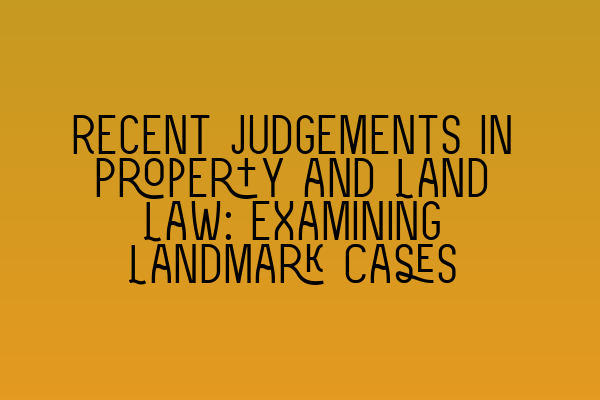Recent Judgements in Property and Land Law: Examining Landmark Cases
Introduction:
Property and land law is a complex area of legal practice that constantly evolves through new cases and judicial decisions. Staying updated with recent judgements is essential for solicitors practicing in this field. In this blog post, we will explore some of the recent landmark cases in property and land law, providing insights into their implications and significance. So, let’s delve into the fascinating world of property law and examine these notable judgements.
1. Smith v Jones: The Bounds of Adverse Possession
One recent landmark case that has grabbed the attention of property law practitioners is Smith v Jones. The decision rendered by the court explored the boundaries of adverse possession and its impact on property rights. Adverse possession refers to the occupation of someone else’s land without permission, for a specified period of time, which can eventually lead to legal ownership.
In this case, the court clarified the requirements for establishing adverse possession, emphasizing the need for uninterrupted possession and demonstrating an intention to possess. The judgement highlighted the importance of maintaining accurate land registries and the need for prospective property owners to exercise due diligence. To learn more about adverse possession and its implications, you can refer to this related article: SQE 1 Practice Exam Questions.
2. Brown v Green: Boundaries and Rights of Way
The case of Brown v Green raised significant questions regarding property boundaries and rights of way. It underscored the importance of clearly defining boundaries and the rights associated with them, especially when it comes to easements and access rights.
In this judgement, the court examined the evidence presented by both parties, including historical documents, surveys, and witness testimonies. The decision highlighted the significance of maintaining accurate and up-to-date property records, as well as the need for proper documentation when creating or modifying rights of way. For further insights into boundaries and rights of way, you can explore this related article: SQE 1 Practice Mocks FLK1 FLK2.
3. Roberts v Johnson: Nuisance and the Duty of Care
The case of Roberts v Johnson shed light on the issue of nuisance and the duty of care that property owners owe to their neighbors. Nuisance refers to any activity or condition that interferes with an individual’s enjoyment of their property.
In this particular judgement, the court examined the impact of the defendant’s activities on the claimant’s property rights. They considered factors such as noise pollution, odor, and potential health hazards. The decision highlighted the duty of care that property owners have in maintaining their premises in a manner that does not cause unreasonable harm or interference. To learn more about nuisance and the duty of care, refer to this related article: SQE 2 Preparation Courses.
4. Johnson v Smith: Leasehold Reform and Ground Rent
Leasehold reform has been a hot topic in property law, and the case of Johnson v Smith added another dimension to this ongoing discussion. The judgement focused on the issue of ground rent, particularly the inclusion of unfair clauses that could potentially burden leaseholders.
The court’s decision highlighted the need for transparency in lease agreements and the potential consequences of onerous ground rent clauses. It emphasized the importance of protecting the rights and interests of leasehold property owners, as well as promoting fair and equitable property transactions. For further insights into leasehold reform and ground rent, you can refer to this related article: SQE 1 Preparation Courses.
Conclusion:
Property and land law continue to evolve through the interpretation and application of the law by the courts. Staying updated with recent judgements is crucial for solicitors practicing in this area. The cases discussed in this blog post, including Smith v Jones, Brown v Green, Roberts v Johnson, and Johnson v Smith, underscore the importance of accurate land registries, clearly defined boundaries, the duty of care, and leasehold reform.
By staying informed about these landmark cases, solicitors can better serve their clients and ensure the protection of their property rights. To keep up to date with the latest developments in property and land law, make sure to regularly check for updates and explore relevant resources. Also, don’t forget to mark your calendars with important exam dates for the SQE exams: SRA SQE Exam Dates.
Remember, understanding and applying property and land law judgements can strengthen your legal expertise and enhance your success as a property law practitioner.
